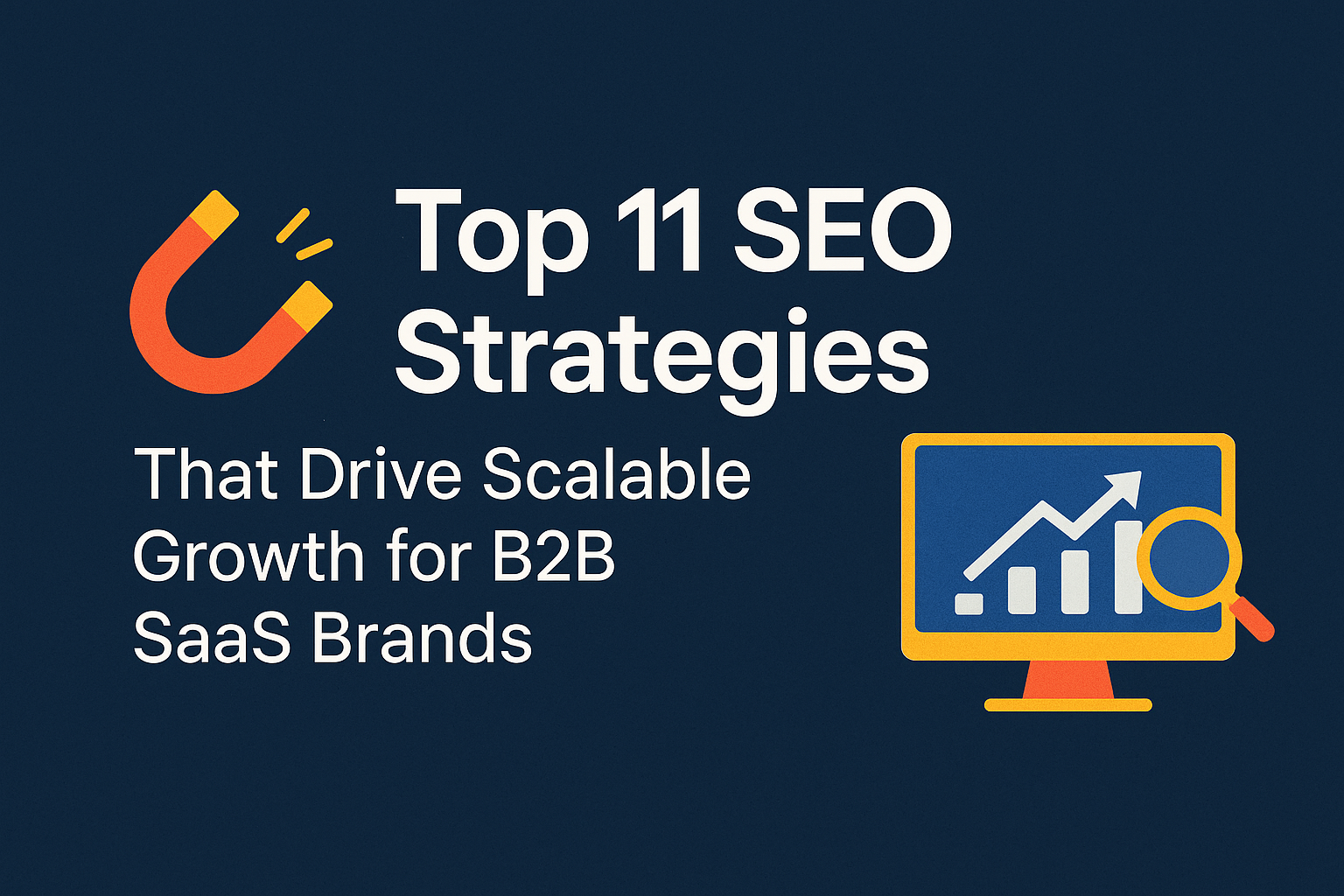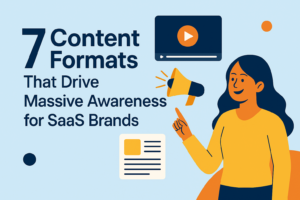B2B SaaS brands operate in a uniquely competitive environment. Unlike B2C, where decisions may be impulsive or emotion-driven, B2B purchases are typically high-value and involve multiple stakeholders. The buyer’s journey is long, research-intensive, and requires trust at every touchpoint. According to Gartner, more than 70% of the B2B buying process occurs before a prospect speaks to a sales representative. This means your online presence—from blogs to product pages—needs to do the heavy lifting.
Search Engine Optimization (SEO) has emerged as one of the most effective, scalable channels for attracting the right audience and moving them through the funnel. Unlike paid ads that stop delivering when the budget dries up, SEO is a long-term asset. It brings consistent visibility, builds authority, and supports the complex research process of B2B buyers.
This comprehensive guide outlines 11 foundational and advanced SEO strategies tailored for B2B SaaS marketers. Each strategy is structured around buyer behavior and how you can align your digital footprint to meet them at every research stage.
# 1. Build a Clean Technical SEO Foundation
Great SEO starts with infrastructure. If your site is slow, hard to navigate, or invisible to search engines, no amount of content will perform. Your website must be fast-loading, secure, mobile-responsive, and well-structured to allow for seamless crawling and indexing.
Start by improving your Core Web Vitals, which Google uses as a ranking signal. Aim for a Largest Contentful Paint (LCP) under 2.5 seconds, a First Input Delay (FID) of less than 100 milliseconds, and a Cumulative Layout Shift (CLS) of less than 0.1. These metrics reflect the real user experience.
Use Google Search Console to identify indexing issues, Screaming Frog to uncover crawl errors or redirects, and PageSpeed Insights to benchmark performance. Fix broken internal links, eliminate duplicate content, implement canonical tags properly, and ensure your XML sitemap and robots.txt file are configured and submitted.
Without this solid foundation, your content and keyword strategies won’t have room to grow.
# 2. Target Buyer Intent with Precision Keyword Mapping
The effectiveness of your SEO strategy hinges on understanding user intent. Keywords must be mapped not just to volume, but to where they fall in the decision-making funnel. This allows you to create content that speaks to a reader’s exact needs, improving both relevance and conversion.
For instance, someone searching “What is B2B SaaS automation?” is at the awareness stage. They need educational content, not a product demo. On the other hand, a search like “Top saas automation tools for legal teams” indicates readiness to evaluate solutions that’s your chance to shine with product pages and comparison content.
Create keyword maps that break your content strategy into three stages:
- TOFU (Top of Funnel): High-level queries, informational content.
- MOFU (Middle of Funnel): Use cases, solution guides, webinars.
- BOFU (Bottom of Funnel): Product comparisons, customer stories, trial CTAs.
This ensures each page has a purpose and aligns with the user’s journey.
# 3. Create Topic Clusters Around Core SaaS Use Cases
Modern SEO isn’t about stuffing pages with keywords, it’s about topical authority. Google wants to see that your site comprehensively covers a subject. Topic clusters help achieve this by connecting related pieces of content around a central theme.
Start with a broad pillar page that covers a core topic relevant to your audience—such as ‘performance tracking for teams’ or ‘improving workplace productivity.’ Then build supporting articles that address specific angles like ‘ways to measure team output,’ ‘common productivity roadblocks,’ or ‘how to streamline project communication workflows.’
Internally link all related articles to the pillar page and vice versa. This structure improves site crawlability, distributes authority, and helps Google understand your domain expertise. Companies that adopt topic clusters often see a 20% boost in organic traffic within three months.
# 4. Structure Content to Win Featured Snippets
Featured snippets those answer boxes at the top of Google results can dramatically increase visibility without higher rankings. Capturing them requires structured content and a clear, direct approach.
To win a snippet, begin your page with a brief paragraph (40–60 words) that directly answers the question your target keyword implies. For step-by-step topics, use clearly numbered lists. For comparisons, tables make information easier to scan. Add headers that reflect user queries, such as “How does this solution improve team efficiency?”
Make your answers stand-alone and easy for Google to extract. Use schema markup where appropriate, especially for FAQs and How-Tos. Over time, you’ll notice higher click-through rates and more visibility in voice search.
# 5. Optimize Pages for AI Overviews and LLM Citations
As AI-powered tools like ChatGPT, Google’s AI Overviews, and Perplexity become primary sources of information, being cited in their summaries is a game-changer for visibility.
These platforms pull data from high-authority, well-structured websites. To increase your chances of being cited:
- Write content that answers questions factually and clearly.
- Avoid buzzwords and keep explanations grounded.
- Include author bios that highlight subject-matter expertise.
- Link to external sources like Gartner, Statista, or official documentation.
For example, Perplexity often pulls from sources like TechCrunch, Investopedia, and company blogs with strong domain authority. Ensure your content includes statistics, original insights, and relevant citations.
Being referenced by an LLM model means your brand is seen in more exploratory conversations—a huge plus for brand recall and consideration.
# 6. Build Authority with E-E-A-T in Every Page
Google’s emphasis on Experience, Expertise, Authoritativeness, and Trustworthiness (E-E-A-T) has reshaped how content should be created—especially in B2B niches where stakes are high.
To reinforce E-E-A-T:
- Add real bylines with verifiable credentials (e.g., “John Smith, 10+ years in XXX industry”)
- Include organization details like company history, certifications, and physical location
- Reference industry benchmarks and third-party studies
- Secure your site with HTTPS, have an accessible privacy policy, and update your About/Team pages regularly
Content that scores high on E-E-A-T is more likely to rank, get featured, and earn backlinks. This isn’t just about perception; it’s a measurable part of your SEO performance.
#7. Design Content for Zero-Click Search Wins
Not all search wins involve clicks. With zero-click searches when Google displays the answer directly on the search results page you still gain visibility and brand equity.
To optimize for this, include concise answers in your content that match “People Also Ask” or “Quick Answers” style queries. Use schema markup to support enhanced results. Embed FAQs into relevant product and blog pages to boost your chance of appearing in answer boxes.
Example:
- Question: “What does a typical workflow timeline look like for a on-page SEO implementation?”
- Answer: “A standard implementation timeline ranges from 1 to 2 weeks, including stages like planning, setup, testing, and launch.”
Even if users don’t click through, they connect your content with reliable and helpful information.
# 8. Refresh and Repurpose Aging Content Regularly
Search intent evolves. So do search algorithms. Content that ranked well last year may be outdated today. Regularly auditing and updating your top-performing content is key to maintaining performance.
Start by reviewing Google Search Console for posts with declining impressions or CTR. Update the content with new data, revised messaging, or added depth. Consolidate similar articles to avoid cannibalization. Add internal links from new content to drive authority.
You can also repurpose evergreen content into:
- A LinkedIn carousel
- A short YouTube video
- A downloadable guide
Doing so keeps your site fresh, multiplies reach, and maximizes ROI from existing efforts.
# 9. Strengthen Internal Linking with Strategic Anchor Texts
Internal links are underutilized SEO assets. They guide users deeper into your content ecosystem and distribute authority across pages.
Build a habit of auditing older posts and linking them to newer content using descriptive anchor text. For instance, instead of saying “click here,” use “learn more about XXX previous blog.”
Also, consider building “resource hubs” or content libraries on key topics where every blog, checklist, and video is cross-linked. This approach not only boosts dwell time but helps search engines map the structure and depth of your site.
# 10. Create Conversion Paths from Content to Pipeline
Traffic without conversion is noise. For each content type, define the next best action. On awareness-stage blogs, offer a downloadable guide, newsletter signup, or webinar invite. On mid-funnel guides, suggest a product comparison checklist or case study. At the bottom of the funnel, provide a free trial or product demo CTA.
Use clear, unobtrusive CTAs embedded naturally into the narrative—not just pop-ups. Measure performance using heatmaps and scroll tracking to see where users are engaging. The best-performing B2B content combines education with subtle nudges toward conversion.
# 11. Track Real Impact with SEO Performance Metrics
To prove and improve SEO, you need to measure what matters. Go beyond keyword rankings and focus on metrics that connect content to business outcomes.
Use Google Search Console to track impressions and CTR by page and query. In GA4, set up goals for content downloads, demo requests, or newsletter signups. Leverage tools like Ahrefs or SEMrush to monitor visibility growth and keyword gaps.
Develop dashboards that visualize:
- Content engagement metrics (time on page, bounce rate)
- Conversion paths (first-touch and assisted conversions)
- Indexation and crawl stats (coverage reports)
Consistent measurement allows you to pivot fast, double down on what works, and communicate value to stakeholders.
Build Long-Term SaaS Growth With These 11 Strategies
SEO is no longer just a traffic channel; it’s a strategic growth lever for B2B SaaS. By following these 11 proven strategies, you lay the foundation for scalable, sustainable visibility that aligns with how your buyers actually search, research, and decide.
Whether you’re refining your technical infrastructure, building topic clusters, optimizing for AI citations, or creating conversion-ready blog content, each of these tactics contributes to a long-term engine of qualified pipeline growth.
The most successful SaaS brands treat SEO not as a one-time campaign but as a core part of their marketing strategy. Start with high-impact actions, stay consistent, and watch your organic visibility and business scale over time.

vetrivel is an accomplished SEO and digital marketing expert with 5 plus years of experience. dedicated to providing readers with informative and engaging content.




